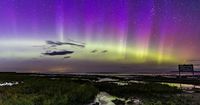Stargazers across the UK are in for a treat as a red alert has been issued for the Northern Lights, a dazzling natural phenomenon that many hope to witness this evening. The alert comes in response to a significant coronal mass ejection (CME) from the sun that struck Earth on April 15, 2025, leading experts to predict a high likelihood of sightings, particularly in the northernmost regions of the country.
According to AuroraWatch UK, the red alert indicates that the spectacular aurora borealis may be visible to the naked eye across the UK, including all of England, provided the skies remain clear and free from excessive cloud cover. This is a rare opportunity for many who typically might not have the chance to see the Northern Lights, which are usually confined to higher latitudes such as Iceland, Canada, Norway, and Finland.
Last night, the aurora was indeed spotted across Scotland as the solar storm intensified, pushing the display further south. The Met Office has suggested that this geomagnetic activity could continue into the night of April 16, particularly in Scotland and the north of England. Their Northern Hemisphere aurora forecast noted, "A coronal mass ejection (CME) arrived at Earth in the late afternoon on April 15. Its associated effects may continue into Wednesday night and may bring aurora to far northern parts of the UK and similar geomagnetic latitudes. The auroral oval will ease to background levels thereafter."
The science behind the Northern Lights is fascinating. These colorful displays are the result of massive solar explosions that eject vast quantities of charged particles, known as solar wind, into space. During a CME, particles are propelled away from the sun at speeds approaching one million miles per hour. When these particles collide with gases in the Earth’s atmosphere, particularly around the magnetic poles, they create the stunning visual effects that many seek to witness.
Experts have indicated that the current solar cycle is at a maximum, which means increased sunspot activity. This heightened solar activity is expected to lead to more frequent and widespread aurora sightings in the coming years, particularly through 2025. Elizabeth J McGrath, a researcher from Colby College, stated, "The sun has been very active recently, and we expect it to continue through 2025. Normally we only see the aurora at locations close to Earth’s magnetic north and south poles because charged particles from the sun get trapped by the Earth’s magnetic field and funneled to the poles. With stronger solar storms during solar maximum, there are more charged particles from the sun, and when these particles interact with Earth’s magnetic field, they can be distributed farther from Earth’s north and south magnetic poles, reaching more southerly latitudes here on Earth."
This increase in visibility is particularly exciting for enthusiasts and casual observers alike, as sightings of the Northern Lights have been reported across the UK in 2024. The best times to catch a glimpse of the aurora typically fall between 9 PM and 2 AM, with the brightest displays often occurring around 11 PM to midnight local time, according to Andy Smith, a researcher at Northumbria University.
Smith noted that the conditions for viewing the Northern Lights can vary significantly based on solar activity and atmospheric conditions. He explained, "Aurora displays occur when charged particles collide with gases in the Earth’s atmosphere around the magnetic poles. In the northern hemisphere, most of this activity takes place within a band known as the aurora oval, covering latitudes between 60 and 75 degrees. When activity is strong, this expands to cover a greater area – which explains why displays can occasionally be seen as far south as the UK."
As excitement builds among the public, many are preparing to head outdoors to catch a glimpse of this celestial show. Communities are buzzing with anticipation, and social media is already filled with tips and recommendations on where to find the best viewing spots. Stargazers are advised to find areas away from city lights to enhance their chances of seeing the aurora.
While the peak of activity was reported last night, the Met Office's ongoing forecasts suggest that the Northern Lights could still be visible tonight for those in the right locations. As the auroral oval eases back to background levels, the opportunity to witness this natural wonder may be fleeting, making it all the more essential for enthusiasts to seize the moment.
In summary, the red alert for the Northern Lights serves as a reminder of the beauty and power of our solar system. With the sun's activity peaking and the potential for auroras reaching further south than usual, this is an exciting time for both seasoned astronomers and curious newcomers alike. Whether you’re in the far northern reaches of the UK or just a little further south, keep your eyes on the sky tonight – you might just catch a glimpse of the breathtaking Northern Lights.



